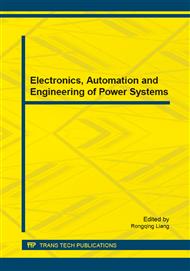p.916
p.921
p.925
p.930
p.935
p.941
p.947
p.952
p.956
Automatic Measurement and Control System of Temperature Rise Test for the Power Electronic Transformers
Abstract:
In the domestic certification bodies the automation degree of the definitive test of the accessories products left much to be improved, as for safety of the transformer conforming to the international standard of IEC61558-1, the traditional manual testing method barely meets the requirements of sampling rate, and has caused a lot of technical deficiencies including inadmissible deviation in the calculation and post-processing of the related experimental data, lengthy work-time of staff, and low test efficiency. In this paper, concerning the type test of various electronic and power transformers, a set of intelligent automatic measurement and control system of the temperature rise test is presented, consisting of software packages with modularized designing and an original hardware apparatus with built-in control modules. Therefore this system is capable of performing a series of operations without human intervention, such as controlling of the related testing equipment, data analysis, real-time monitoring, timing acquisition and data processing of corresponding algorithms, auto-save of test configuration and generating original record of the test. Thus, the idea of ‘Full automation with only one simple configuration’ has truly been realized. The experimental results show that compared with the traditional testing method, the application of this system minimized uncertainty caused by human factors in the testing process and improve precision of data analysis, and also ensured the reproducibility, consistency and traceability of the test results effectively.
Info:
Periodical:
Pages:
935-940
Citation:
Online since:
February 2015
Authors:
Keywords:
Price:
Сopyright:
© 2015 Trans Tech Publications Ltd. All Rights Reserved
Share:
Citation:


